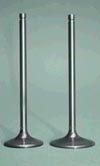Valve Surface Treatments
 In recent articles, we have assessed some of the materials employed in the manufacture of racing valves. This month we will take a break from this recent theme, and take a brief look at some of the surface treatments used on racing valves, perhaps returning in the future to look more deeply at some of them.
In recent articles, we have assessed some of the materials employed in the manufacture of racing valves. This month we will take a break from this recent theme, and take a brief look at some of the surface treatments used on racing valves, perhaps returning in the future to look more deeply at some of them.
In terms of surface treatments, we can split these into three basic groups:
- Coatings, which are applied on top of the bulk material
- Surface hardening treatments, which alter the mechanical properties or composition of the valve material itself
- Mechanical treatments, which work the surface of the valve.
If we take these in order, the first and probably most important group is that of coatings. Many of you are probably familiar with the main hard coatings that have become so popular in recent times. Certainly there are many valve manufacturers who offer coated valves with this type of coating. Titanium valves, owing to the properties of the material are ripe candidates for these coatings. As we have discussed in other articles, the surface behaviour of titanium when sliding, even under modest pressure is not good, especially if lubrication is scarce. Chromium Nitride, Titanium Nitride and diamond-like carbon (DLC) coatings are all popular. Prior to their prominence, it was quite common for the valves to have their stems coated with another, more wear resistant metal. Molybdenum, which has other uses in racing engines for sliding applications, is probably the main metal sprayed coating used for this purpose. The valve is prepared by machining the stem slightly in the area required for the metal spraying, and afterwards the stem is re-ground to the correct size along the entire length. Hard surface coatings also have great value on the seat area of the valve, preventing damaging material transfer between valve and seat. This is especially pertinent in the case of titanium, which can suffer from serious problems in this area.
The surface hardening treatments are generally applied to steel valves, which are generally made from austenitic steels. Both nitriding and low temperature nitrocarburising treatments are popular for this application, and both are done at around 500 – 550 degrees C. both of these treatments diffuse nitrogen into the surface of the metal and owing to the high percentage of chromium in the material, both treatments work very well. The chief advantages are an increase in hardness of the surface and greater wear resistance, coupled with an increase in fatigue strength on account of the residual compressive stress associated with both of these processes.
The final category is mechanical treatments, and whilst these can be said to work the surface of the material, it is likely that any significant residual compressive stress is relieved by temperature effects, especially in the exhaust valve. However, the main benefit to both shot-peening and the helical ‘brushed’ finish sometimes used on the back of the valve head and the lower stem is probably in disrupting any remaining machining marks, which would have a benefit in terms of fatigue.
Written by Wayne Ward.